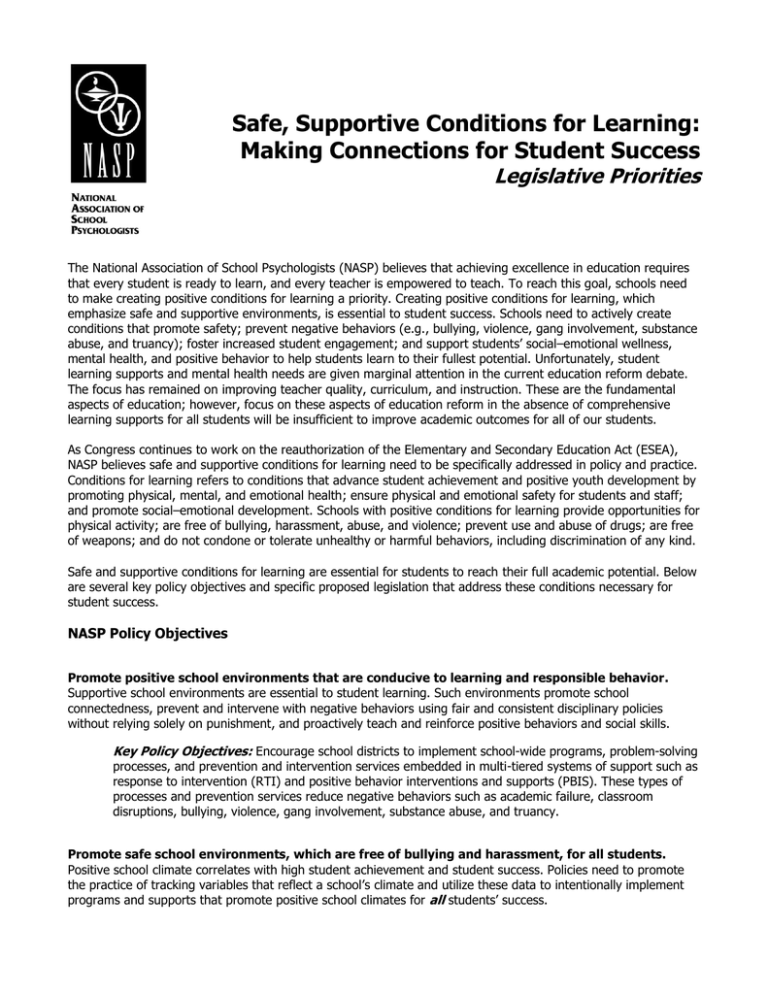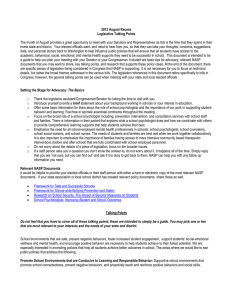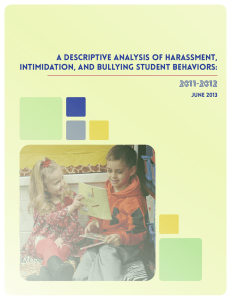Safe, Supportive Conditions for Learning: Making Connections for Student Success Legislative Priorities
advertisement

Safe, Supportive Conditions for Learning: Making Connections for Student Success Legislative Priorities The National Association of School Psychologists (NASP) believes that achieving excellence in education requires that every student is ready to learn, and every teacher is empowered to teach. To reach this goal, schools need to make creating positive conditions for learning a priority. Creating positive conditions for learning, which emphasize safe and supportive environments, is essential to student success. Schools need to actively create conditions that promote safety; prevent negative behaviors (e.g., bullying, violence, gang involvement, substance abuse, and truancy); foster increased student engagement; and support students’ social–emotional wellness, mental health, and positive behavior to help students learn to their fullest potential. Unfortunately, student learning supports and mental health needs are given marginal attention in the current education reform debate. The focus has remained on improving teacher quality, curriculum, and instruction. These are the fundamental aspects of education; however, focus on these aspects of education reform in the absence of comprehensive learning supports for all students will be insufficient to improve academic outcomes for all of our students. As Congress continues to work on the reauthorization of the Elementary and Secondary Education Act (ESEA), NASP believes safe and supportive conditions for learning need to be specifically addressed in policy and practice. Conditions for learning refers to conditions that advance student achievement and positive youth development by promoting physical, mental, and emotional health; ensure physical and emotional safety for students and staff; and promote social–emotional development. Schools with positive conditions for learning provide opportunities for physical activity; are free of bullying, harassment, abuse, and violence; prevent use and abuse of drugs; are free of weapons; and do not condone or tolerate unhealthy or harmful behaviors, including discrimination of any kind. Safe and supportive conditions for learning are essential for students to reach their full academic potential. Below are several key policy objectives and specific proposed legislation that address these conditions necessary for student success. NASP Policy Objectives Promote positive school environments that are conducive to learning and responsible behavior. Supportive school environments are essential to student learning. Such environments promote school connectedness, prevent and intervene with negative behaviors using fair and consistent disciplinary policies without relying solely on punishment, and proactively teach and reinforce positive behaviors and social skills. Key Policy Objectives: Encourage school districts to implement school-wide programs, problem-solving processes, and prevention and intervention services embedded in multi-tiered systems of support such as response to intervention (RTI) and positive behavior interventions and supports (PBIS). These types of processes and prevention services reduce negative behaviors such as academic failure, classroom disruptions, bullying, violence, gang involvement, substance abuse, and truancy. Promote safe school environments, which are free of bullying and harassment, for all students. Positive school climate correlates with high student achievement and student success. Policies need to promote the practice of tracking variables that reflect a school’s climate and utilize these data to intentionally implement programs and supports that promote positive school climates for all students’ success. Key Policy Objectives: Ensure that instruction, assessments, and interventions are responsive to students’ individual needs, backgrounds, and circumstances, including culture and language. Encourage policies that require schools to specifically prohibit bullying and harassment, including conduct based on a student’s actual or perceived race, color, national origin, sex, disability, sexual orientation, gender identity, gender expression, or religion. Ensure that schools and school districts implement effective school-wide bullying prevention programs to better prevent and respond to incidences of bullying and harassment. Ensure that data regarding incidents of bullying and harassment are tracked and reported to states, districts, communities, and parents. Expand accountability systems to include school climate, student wellness, and family–school collaboration. Provide sufficient access to learning and mental health services and supports. Learning supports are essential to student success and should guide education reform efforts. Comprehensive and coordinated learning supports directly contribute to increased student outcomes and increased achievement. ESEA must explicitly promote policies and funding that improve student access to specialized instructional support personnel who can provide the learning and mental health services, supports, and leadership to ensure that all student needs are identified and met. Key Policy Objectives: Provide sufficient student support services and qualified school personnel in order to promote healthy learning and development by coordinating services across a continuum of care that integrates schools, families, and the community. Include effective measures of home–school– community collaboration as part of school accountability efforts. Encourage policies that establish programs fostering supportive relationships between students and caring adults (e.g., mentoring, educational liaisons, educational advocates, program coordinators). Provide federal leadership that prioritizes comprehensively identifying and responding to barriers to learning. Connections to 112th Congress Proposed Legislation Successful, Safe, and Healthy Students Act of 2011 S. 919. Awards grants to states to develop, improve and implement state reporting and information systems that measures condition for learning, based on surveys of school students and staff. Awards competitive subgrants to local education agencies or nonprofit organizations that use such measurement systems to make comprehensive improvement to school-level conditions for learning. Academic, Social, and Emotional Learning Act of 2011 H.R. 2437. Allows professional development funds to include teacher and principal training in practices that address the social and emotional development needs of students. Allows funded training to include training in classroom instruction and school-wide initiatives that enable students to acquire the knowledge, attitudes, and skills most conducive to social and emotional competency. Positive Behavior for Safe and Effective School H.R. 3165. Allows State educational agencies, local educational agencies, and schools to increase implementation of school-wide positive behavior supports. Increased Student Achievement Through Increased Student Support Act H.R. 3405. Directs the Secretary of Education to award competitive, renewable, 5-year grants to partnerships between low-income local educational agencies and schools offering graduate programs in school counseling, social work, or psychology to increase the number of program graduates employed by low-income LEAs. Safe Schools Improvement Act. S. 506 and H.R. 1648. Requires schools and school districts to ban bullying and harassment. It would ensure that schools protect students whether they are being targeted based on their race, gender, religion, real or perceived sexual orientation, or any other basis. Student Nondiscrimination Act of 2011 S. 555 & H.R. 998. Ends discrimination based on actual or perceived sexual orientation or gender identity to public schools. For more information, visit http://www.nasponline.org/advocacy. See other briefing handouts for key concepts and research. © 2011 National Association of School Psychologists, 4340 East West Highway, Suite 402, Bethesda, MD 20814—(301) 657-0270.






![Bullying and Harassment Advisor role des[...]](http://s3.studylib.net/store/data/006976953_1-320eb77689e1209d082c9ec2464350ee-300x300.png)

